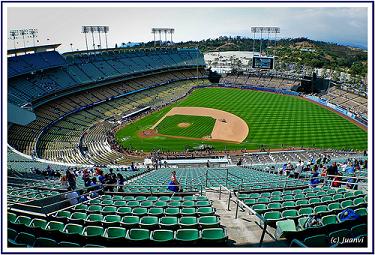Dodger Stadium, Home of the
Los Angeles Dodgers

Photo Credit

Dodger Stadium Overview
Dodger Stadium, located near the downtown area of Los Angeles, is the 3rd oldest ballpark in Major League Baseball after only Fenway Park in Boston and Wrigley Field in Chicago.

With a seating capacity of 56,000, it has been the home of the Los Angeles Dodgers since 1962. Construction of the stadium cost $23 million.
Including several World Series contests, the stadium has hosted numerous special games such as the MLB All-Star Game in 1980, exhibition baseball for the 1984 Summer Olympics, and the World Baseball Classic in 2009.
Dodger Stadium Quick Facts
- Location: 1000 Elysian Park Avenue in Dodgertown, California 90090-1112
- Years: April 10, 1962 to present
- Seating Capacity: 56,000; 57,099 (including standing room)
- Surface: Natural Grass
- Architect: Captain Emil Praeger
- Project Cost: $23 million
Dodger Stadium History
The president of the Brooklyn Dodgers, Walter O'Malley, first tried to build a stadium in New York City during the mid part of the 1950s. This never happened though because he could not reach an agreement with NYC city officials to acquire land. Thus, O’Malley turned his attention to the city of Los Angeles.

The city of Los Angeles purchased land from local owners and inhabitants in the early 1950s using funds provided by the 1949 Federal Housing Act. The city intended to use the land for a public housing project but the idea lost public support. Thus, after a voter referendum, the city sold the land to the Dodgers.
While the Dodgers were constructing its stadium (1958 - 1961) the team played at the Los Angeles Memorial Coliseum. The coliseum seated more than 80,000 people.
The Dodger's ballpark was the first one built with all private financing since the original Yankee Stadium. The digging began on the 17th of September in 1959. The stadium was designed originally so that it could expand its seating capacity to 85,000 by making the upper decks larger and extending the seating area over the pavilions in the outfield. This was never done though.
Some of the design features were quite innovative. One was the screened dugout-level seats behind home plate. Walter O'Malley copied this idea from the Korakuen Stadium in Tokyo when the Brooklyn Dodgers were on a goodwill tour there in 1956. This dugout seating was renovated in 1999 and replaced with more traditional box seating.

Some other features include the wavy roof on top of each of the outfield pavilions and the Dodger’s logo on the top part of an elevator shaft located right behind the home plate in the upper seating area.
Originally Dodger Stadium had two big electronic scoreboards by Fair Play. One was above the right-field pavilion and the other one was above the left-field pavilion. These were replaced through the years with more updated models.
The Dodgers have no plans of replacing this stadium with a new design. They spend a lot of resources each year to maintain the stadium and surrounding area. It was renovated in 1999 and in 2004 adding some seats at field level behind home plate. By 2010, the stadium had 2,098 club seats along with 68 luxury suites. Any further renovations are on hold at the moment.
The playing field dimensions of
Dodger Stadium
are 330 feet on the foul lines, 375 feet in the power alleys, and 395 feet to the fence in center field.
If you're considering going to a Dodgers game, Buy and Sell Tickets Here!

